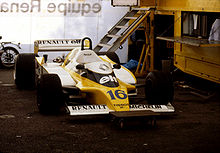The conflict between FISA and FOCA is a confrontation between two representative organizations in Formula 1 in the early 1980s , a subcommittee of the International Federation of Motor Sports (FISA) and the Formula 1 Designers Association (FOCA). The culmination of the confrontation - all the teams united in the FOCA boycotted the 1982 San Marino Grand Prix .
In theory, all FOCA teams should have boycotted the Grand Prix as a sign of solidarity and dissatisfaction with the rules and the distribution of financial compensation. (In addition, one cannot fail to note strong opposition to the candidacy of FISA President Jean-Marie Balestra from Colin Chapman of Lotus and Frank Williams of Williams , who openly announced their retirement if he was accepted). In practice, some FOCA teams (Tyrrell, Toleman) still participated in the race, justifying themselves with “obligations to sponsors”.


FOCA team bosses explained the boycott in response to the disqualification of Nelson Pique ( Brabham ) and Keke Rosberg ( Williams ) at the earlier Brazilian Grand Prix in 1982 . The disqualification, in turn, was caused by a response to an attempt by FOCA teams to overcome the lack of power of cars without turbochargers (Renault was the first team to use turbochargers in the late 1970s).
Before the Brazilian race, FOCA teams found a loophole in the procedure for weighing machines. According to the rules, the machines had to be weighed with all coolants and lubricants , but nothing was said about the need for their presence in the machine after starting.
FOCA teams said that this means the ability to "top up" the spent fluids, although this practice was banned in other FIA races, it was not mentioned in Formula 1.
For the Brazilian race, FOCA teams have proposed special "water-cooled brakes." They equipped all their cars with rather large water tanks. In practice, for no cooling, of course, water was not used, but simply gradually poured out of the tanks at the beginning of the race. Naturally, the car was immediately relieved (even below the set minimum), and the cars drove much faster. And before the end of the race (at the pit stop) or even after the finish, the tanks were again filled with water, and the weight again became acceptable. Since water was declared as a cooler, this action was not in conflict with the rules of Formula 1.
The confrontation ended with the mutual agreement of FISA and FOCA; in fact, the inclusion of some FOCA leaders in the FIA, such as Bernie Ecclestone and Max Mosley . The Consent Agreement has accelerated the commercialization of Formula 1. Promoters can now be sure that “all 26” (or how many will make their debut at the beginning of the season) cars will appear in the races of this season, which automatically increased sponsorship investments and commercial benefits and reduced risks. This significantly increased financial compensation to teams (including non-FOCA manufacturers).
Interestingly, the Tyrrell team was disqualified from the 1984 season for trying to equalize the lack of power compared to the turbo engines of teams such as Brabham and Williams , violating the rules, using inappropriate fuel. This was one of the echoes of the conflict, showing the FIA's desire to create a level playing field for all teams, regardless of the type of motors.
Literature
- (English) Henry, Alan (1985). Brabham, the Grand Prix Cars. Osprey. ISBN 0-905138-36-8 .